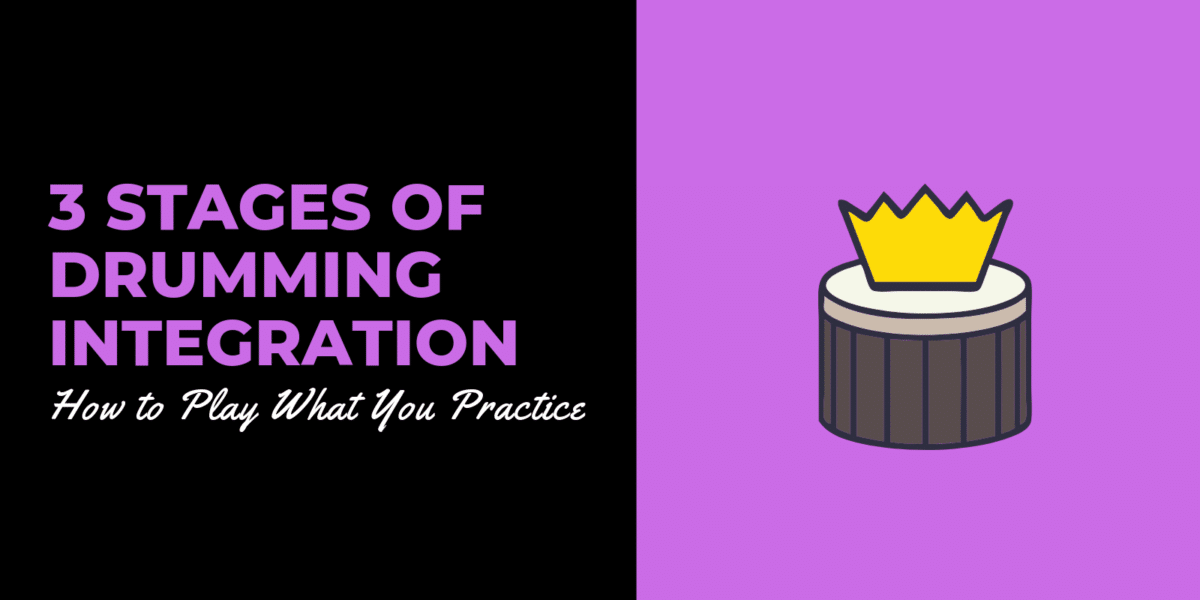During my college days, learning to drum was simple. My only job at the time was to get better at my instrument, and this single focus made it much easier to grow skills quickly. I had hours of free time dedicated to practicing, I was surrounded by music, and there were world class instructors and musicians all around me.
At the time, my life revolved around drums and I had the time and exposure to practice and grow as a musician. These days, that is no longer the case. I now teach drums full time, and between building this website and a busy gigging schedule, I’m left with little time to practice drums.
As I’ve explained many times, your drum skill is directly related to the amount of practice time you put in. But for the majority, if you aren’t going to school for drums, the amount of time you have available for practice is small.
Most of you are not attending college for drumset, however, many of you still wish to be a better drummer. Balancing practice time between work, family, friends, and the thousands of other commitments we have can be difficult.
So how can a drummer squeeze the most value out of their precious little practice time? There are many different ways to approach a short practice session, but two of the most effective methods are by using compound and isolation drumming exercises.
Do You Even Lift, Bro?
Maybe it’s because I like to exercise, or maybe it’s because I think fitness is a language many of us understand, but I like to compare practicing music to working out. The similarities between exercise and practice are many. Destroying yourself in order to build new strengths, showing up even if you don’t want to be there, and building neurological pathways are a few of the many ways that the two activities are mutual.
Just like there are many different ways to work out, there are different styles to practicing drums. Some may seem better than others, but I prefer to look at it as some methods are more appropriate than others. For example, if you were training for a weight lifting competition, you may not want to focus your exercise time on long distance running. This same approach applies to practicing drums.
Know Your Goals
If you need to learn 100 songs for an upcoming coverband gig, practicing your double strokes may not be the best use of your time. Or if you have an upcoming gig with a fusion band, you may want to practice building chops and odd time playing instead of trying to memorize the drums to Boston’s More Than a Feeling.
Knowing your practice goals is a key factor in determining how you are going to approach each session. Even if you’re not working towards something, it’s important to at least put that in your mind. Think, “I don’t have anything specific to learn, so today’s practice session is going to be a general, all around maintenance session.”
Make a Plan
It doesn’t have to be very detailed, but making a rough plan of how your practice session is going to go will keep you on track. When I am on my way to the practice room, I will make a mental note of what I’m trying to accomplish, how much time I have, and how I’m going to spend that time.
The more detailed you can plan a session, the more you’ll get out of it. Going in without any plan will only waste your precious time, and keep you off-track. If time is of the essence, careful planning is going to help your practice sessions be more fruitful.
Compound Vs. Isolation Exercises
If you have spent some time in the gym, you probably already understand the concept of compound and isolation exercises. Each exercise has their advantages and disadvantages, and it’s important to know when and where you’d want to do each one.
Consider a bench press vs an arm curl. The bench press is considered a compound exercise. It is focused around the chest, but has the advantage of hitting the shoulders, arms, and abs all at the same time. On the other hand, the arm curl is an exercise that only focuses on the biceps. Each exercise has their place, but it’s important to know when to do them.
Overall, since compound exercises hit many different muscle groups at once, I would consider those exercises a better “bang for your buck”. On the other hand, isolation exercises are a great way to pinpoint weaknesses and specific areas. Depending on your goals, you can now figure out which exercise is best for what you want to accomplish.
But that’s enough about working out. We’re here to discuss drumming and not lifting weights. So let’s get to the topic at hand and discuss the difference between compound and isolation drumming exercises.
Isolation Drumming Exercises
If you’ve followed the advice above, hopefully you have already made a mental note of how long your practice session is going to be, and what specifically you need to work on. If there is an immediate task at hand that requires something specific, this would be a perfect time for isolation drumming exercises. An isolation exercise would be something that is geared to a very specific aspect of your drumming.
These days, when I step in the practice room, more often than not I have something specific I need to work on. It could be memorizing songs for a gig, learning a chart, or practicing a style of drumming. In most cases, I usually have a singular goal in mind.
Because other commitments tend to take up my time during the day, I no longer have the luxury of limitless practice time to work on everything. I now need to be choosy with what I practice. My practice time is precious, and if something specific needs to be worked on, I will use isolation exercises.
Some examples of isolation exercises include:
- memorizing songs
- learning a specific drum groove
- practicing a singular style of music
- working on a specific technique
- working on rudiments
- learning a chart
- patterns and fills
For many practice sessions, isolation exercises are a necessity and are the best way to spend your time. I prefer isolation exercises if I have something very specific I need to work on. Maintaining all of my focus on a single task provides me with the greatest results.
However, there are also times when there is nothing specific that needs to be worked on. In this case, I prefer to go with the more general approach and focus on compound drumming exercises.
Compound Drumming Exercises
If we’re assuming that we have a short amount of practice time available, it’s important to get the most out of the little time we have. If our session has no immediate tasks that need to be worked on, compound practice exercises are the way to go. Compounding an exercise is when we take any normal exercise and simultaneously add something else to it. This is a great way to double the effectiveness of any given exercise.
For example, practicing your double stroke roll would be considered an isolation exercise. This is because our focus is only on double strokes and nothing else. However, if we were to open up a snare method book (How about Pratt’s 14 Modern Contest Solos) and read through one of the passages, we would be tackling double stroke rolls along with many other rudiments. This turns your double stroke practice into a compound exercise. The idea is that we can cover a lot more ground and improve on multiple weaknesses with less time.
Compound drumming exercises are easier said than done. For many of us, we’ll need to build up the skills to even begin to tackle some of these exercises. However, there are plenty of ways to add compound practices into our every day routines and it’s worth taking the time to learn how to do it.
Use a Metronome
Adding a metronome to whatever you practice is one of the easiest ways to get more out of your time. If you don’t already use a metronome for the majority of your practice sessions, now is the time to start. Not only will it help you keep time, but it is a great way to turn any regular exercise into a compound exercise.
By adding a metronome to your already existing practice routines, you get the benefit of adding strict time skills to whatever you are playing. Using a metronome helps keep you in time, but it also aids with spacing notes properly, and gives you benchmarks for your technical limits.
If you can get into the habit of taking notes, using a metronome is a great way to add some structure to your practice sessions. I like to take notes of the tempos I was practicing at. This way, when I come back the next day, I already know what tempo I peaked at last time and have something to aim for.
Don’t forget that practicing things slower is also important. It’s not always about speed. I also like to take notes on how slow I can play things as well. This way I can identify what tempos feel awkward, and where things start to feel uncomfortable.
Add Foot Ostinatos
If you’re working on exercises for your hands, one of the best ways to get more out of your time is to add a foot ostinato underneath. In drumming, an ostinato is a repetitive pattern that continues to play unchanged. Ostinatos can be played with any voice on the drums, however they are commonly played by the feet.
An example of a simple foot ostinato is the Bossa Nova foot pattern:

By using repetitive foot ostinatos like the bossa nova, we can turn any exercise played in the hands into a compound exercise. Personally, I rarely do any type of hand warmup without playing some type of foot ostinato underneath. When in a time crunch, this is hands down the best way to cover a lot of ground quickly.
As an example, we could play the first two exercises of stick control on the snare while playing the bossa foot pattern underneath:

Compounding foot patterns with hand exercises helps build timing between the hands and feet, coordination, and is important for limb independence. I will admit, to get to the point where you can comfortably add foot patterns to whatever you are doing with your hands will take some time, but it is worth the extra effort.
Depending on your skill level, there are many different patterns that can be tried with the feet. I start most students with just quarter notes on the bass drum. Once that is easy enough, you can add the hi hat on 2&4. Eventually, you can move to more elaborate patterns such as left foot clave over a tumbao kick pattern.
Add Ostinatos to Reading Exercises
If you are working on your reading, a great way to add a little more difficulty to the practice is by adding ostinatos over top. This gives you the added benefit of not only working on your reading, but also practicing your independence and coordination as well. Add a metronome, and you’ve got yourself a winning combination.
As an example, let’s assume you are reading a passage of 8th notes:

One way to compound the exercise would be to move the reading to the bass drum and add a hand ostinato over top. If we turn it into a rock pattern, we also get the added benefit of having something a bit more fun to play.
Here is a simple rock hand ostinato that we could try:

When played over top of the previous 8th note reading passage, it would look something like this:

Adding different ostinatos over your reading should become standard practice. This concept becomes especially important when you want to take the plunge into jazz drumming. So go ahead and give it a try.
Click here for a list of some ostinatos that you can try on your own.
Putting it All Together
When short on practice time, our goal should be to accomplish as much as we can with the time we have. Firstly, being prepared before you begin is extremely important. Know how much time you have and what needs to be worked on.
If there is something immediate that needs to be learned, then focus on isolation exercises to accomplish the task at hand.
However, if there is nothing pressing to work on, using compound exercises is a great way to maximize your time. By adding different patterns over top of whatever we are practicing, we can compound our exercises and get more value out of our time.
Remember that you should always be using a metronome no matter what you are doing.
How do you practice if you are short on time? What are some of your go to exercises? Comment below and let me know!










This is something most of us need. More effective practice when we don’t have as much time as we wish we had. Thanks Duran.
Thanks Paul. There’s never enough time!